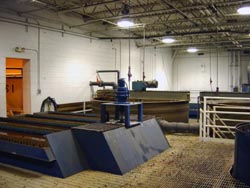Lead: Secondary Lead Smelter eTool
Environmental Controls » Waste Water Treatment

Normally, employees are not exposed to hazardous levels of airborne lead contaminants during the service and maintenance of waste water treatment systems. However, during the handling of lead-bearing wastes, sludges, and filters employees may come in contact with lead-containing wastes.

Potential Sources of Exposure
-
Liquid lead waste may splash on equipment and become airborne if it dries and becomes disturbed.
-
Employees may contact leaded waste products during removal and transport of recovered lead.
Possible Engineering and Work Practice Controls
-
Ensure that appropriate PPE is provided and used when handling leaded materials.
-
Transfer recovered lead in covered or closed containers.
-
Clean up spills and water mists, when necessary, to prevent leaded materials from drying.

